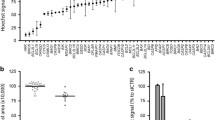Abstract
Human sacral chondrosarcoma, the most common one of malignant tumors, has a potent capacity to invade locally and metastasize. Notably, CXCR4 and survivin are widely recommended as a candidate of the molecule-targeted therapy. However, the roles and associations of CXCR4 and survivin in sacral chondrosarcoma have not been well characterized. Here, we investigated CXCR4 and survivin expression in human sacral chondrosarcoma. Resected sacral chondrosarcoma specimens were available from 30 patients. In vitro human chondrosarcoma cell lines SW1353 was used. Immunohistochemistry, Western blot, RNA interference, and cell cycle analyses were conducted. Immunohistochemistry revealed that CXCR4 and survivin expressed in 83.3 and 86.7 % of sacral chondrosarcoma tissues, respectively, and both were closely associated with grade and recurrence (p < 0.05). Western blot revealed that survivin expression in SW1353 increased in a dose- and time-dependent manner following SDF-1 treatment. However, the interference with MEK/ERK and PI3K/AKT pathway affected SDF-1-induced up-regulation of survivin. Besides survivin siRNA affected cell cycle progression and the expression of epithelial–mesenchymal transition (EMT) biomarkers: Snail and N-cadherin, when compared with those of non-transfection. In conclusion, the present study shows that SDF-1/CXCR4 signaling up-regulates survivin via MEK/ERK and PI3K/AKT pathway, leading to cell cycle and EMT occurrence in human sacral chondrosarcoma. The antagonizing of CXCR4 and/or survivin might benefit patients with sacral chondrosarcoma.




Similar content being viewed by others
References
Randall RL, Bruckner J, Lloyd C, et al. Sacral resection and reconstruction for tumors and tumor-like conditions. Orthopedics. 2005;28:307–13.
Bergh P, Gunterberg B, Meis-Kindblom JM, et al. Prognostic factors and outcome of pelvic, sacral, and spinal chondrosarcomas: a center-based study of 69 cases. Cancer. 2001;91:1201–12.
Leone A, Costantini A, Guglielmi G, et al. Primary bone tumors and pseudotumors of the lumbosacral spine. Rays. 2000;25:89–103.
Rhomberg W, Eiter H, Böhler F, et al. Combined radiotherapy and razoxane in the treatment of chondrosarcomas and chordomas. Anticancer Res. 2006;26:2407–11.
Polyak K, Weinberg RA. Transition between epithelial and mesenchymal states: acquisition of malignant and stem cell traits. Nature Rev Cancer. 2009;9:265–73.
Mani SA, Guo W, Liao MJ, et al. The epithelial–mesenchymal transition generates cells with properties of stem cells. Cell. 2008;16:704–15.
Nieto MA. Epithelial plasticity: a common theme in embryonic and cancer cells. Science. 2013;342:1234850.
Wheelock MJ, Shintani Y, Maeda M, et al. Cadherin switching. J Cell Sci. 2008;121:727–35.
Nurwidya F, Takahashi F, Murakami A, et al. Epithelial mesenchymal transition in drug resistance and metastasis of lung cancer. Cancer Res Treat. 2012;44:151–6.
Thiery JP, Sleeman JP. Complex networks orchestrate epithelial–mesenchymal transitions. Nat Rev Mol Cell Biol. 2006;7:131–42.
Gao D, Vahdat LT, Wong S, et al. Microenvironmental regulation of epithelial–mesenchymal transitions in cancer. Cancer Res. 2012;72:4883–9.
Dave B, Mittal V, Tan NM, et al. Epithelial–mesenchymal transition, cancer stem cells and treatment resistance. Breast Cancer Res. 2012;14:202.
Roy I, Evans DB, Dwinell MB. Chemokines and chemokine receptors: update on utility and challenges for the clinician. Surgery. 2014;155:961–73.
Yoshie O. Chemokine receptors as therapeutic targets. Nihon Rinsho Meneki Gakkai Kaishi. 2013;36:189–96.
Li W, Chen YQ, Shen YB, et al. HIF-1α knockdown by miRNA decreases survivin expression and inhibits A549 cell growth in vitro and in vivo. Int J Mol Med. 2013;32:271–80.
Skoufias DA, Mollinari C, Lacroix FB, et al. Human survivin is a kinetochore-associated passenger protein. J Cell Biol. 2000;151:1575–82.
Lladser A, Sanhueza C, Kiessling R, et al. Is survivin the potential Achilles’ heel of cancer? Adv Cancer Res. 2011;111:1–37.
Zuryń A, Litwiniec A, Gackowska L, et al. Expression of cyclin A, B1 and D1 after induction of cell cycle arrest in the Jurkat cell line exposed to doxorubicin. Cell Biol Int. 2012;36:1129–35.
Park WH, Seol JG, Kim ES, et al. Arsenic trioxide-mediated growth inhibition in MC/CAR myeloma cells via cell cycle arrest in association with induction of cyclin-dependent kinase inhibitor, p21, and apoptosis. Cancer Res. 2000;60:3065–71.
Biliran H Jr, Wang Y, Banerjee S, et al. Overexpression of cyclin D1 promotes tumor cell growth and confers resistance to cisplatin-mediated apoptosis in an elastase-myc transgene-expressing pancreatic tumor cell line. Clin Cancer Res. 2005;11:6075–86.
Schwindt TT, Forti FL, Juliano MA, et al. Arginine vasopressin inhibition of cyclin D1 gene expression blocks the cell cycle and cell proliferation in the mouse Y1 adrenocortical tumor cell line. Biochemistry. 2003;42:2116–21.
Payton M, Chung G, Yakowec P, et al. Discovery and evaluation of dual CDK1 and CDK2 inhibitors. Cancer Res. 2006;66:4299–308.
L’Italien L, Tanudji M, Russell L, et al. Unmasking the redundancy between Cdk1 and Cdk2 at G2 phase in human cancer cell lines. Cell Cycle. 2006;5:984–93.
Ahn SH, Jeong EH, Lee TG, et al. Gefitinib induces cytoplasmic translocation of the CDK inhibitor p27 and its binding to a cleaved intermediate of caspase 8 in non-small cell lung cancer cells. Cell Oncol (Dordr). 2014;37:377–86.
Xu J, Lamouille S, Derynck R. TGF-beta-induced epithelial to mesenchymal transition. Cell Res. 2009;19:156–72.
Wendt MK, Allington TM, Schiemann WP. Mechanisms of the epithelial–mesenchymal transition by TGF-beta. Future Oncol. 2009;5:1145–68.
Miyazono K. Transforming growth factor-beta signaling in epithelial–mesenchymal transition and progression of cancer. Proc Jpn Acad Ser B Phys Biol Sci. 2009;85:314–23.
Acknowledgments
We gratefully thank other members of our Lab for their critical reading of this paper and valuable suggestions.
Conflicts of interest
None.
Author information
Authors and Affiliations
Corresponding author
Rights and permissions
About this article
Cite this article
Yang, P., Wang, G., Huo, H. et al. SDF-1/CXCR4 signaling up-regulates survivin to regulate human sacral chondrosarcoma cell cycle and epithelial–mesenchymal transition via ERK and PI3K/AKT pathway. Med Oncol 32, 377 (2015). https://doi.org/10.1007/s12032-014-0377-x
Received:
Accepted:
Published:
DOI: https://doi.org/10.1007/s12032-014-0377-x




